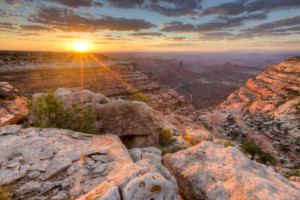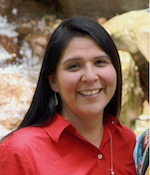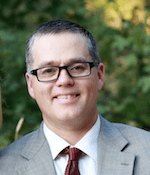By Nate Thomas and Nizhone Meza for EDRBlog.org

Starting, conducting and completing a “situation assessment” for inexperienced yet enthusiastic protégés in the Environmental Dispute Resolution Program Short Course can be an overwhelming task. Thankfully, we found a way to maximize our experience: by working together, we had someone to bounce ideas around with and someone to share the load. We became optimistic working as a team to improve tribal relations and consultation in the state of Utah for our Short Course capstone project.
One course reading advises that, “Before proceeding with any collaborative process, it is essential that an assessment be conducted. A thorough assessment uncovers the context, history, and dynamics of the situation as well as the potential obstacles to collaboration that will need to be overcome” (Carlson, A Practical Guide to Collaborative Governance). We took this statement to heart as we conducted each interview, especially when we were faced with the historical and legal context and dynamics of the relations with Indian tribes and the United States of America. We knew that there are often numerous obstacles that can prevent an effective collaboration on tribal consultation. But we wanted to show that by working together, we could plant the seeds of a potential collaborative project or at least the seeds to begin improving tribal relationships with the BLM.
After a few sessions, we realized that we shared common ground in our desire to improve relationships between the Bureau of Land Management (BLM) and American Indian Tribes in Utah. Nizhone’s interests stem from her American Indian heritage and her work with Utah Diné Bikéyah. Nate was impressed by her rich educational background, her ability to really listen beyond the spoken word, her willingness to teach, and her passion about Tribes having a seat at the agency table. Nate’s interests are founded in his 9 years of work as a tribal liaison for the BLM. Nizhone was impressed by his extensive experience, his openness to learn another perspective, and his commitment to improving relations between Tribes and the federal government. Our mutual interests helped bridge two organizational cultures whose perspectives and interests come from opposite sides of the consultation table. We recognized that this project was not for the faint of heart. Yet, as we worked as a team, bringing our backgrounds together, we gained a greater understanding of the values and interests involved from the people we interviewed in our situation assessment.
Get notified when new articles are posted to the EDR blog – sign up for our email list »
Tallbull and Deaver in the foreword to Native Americans and Archaeologists: Stepping Stones to Common Ground state, “All people have connections to the places where they live, work, and play. People form relationships with these places. People define places as good, powerful, and safe. They find comfort by living in these places. There is a sense of belonging that is valued” (Swidler, Dogoske, Anyon, & Downer). The complexities of the multiple-use mission that directs the BLM, adds an additional paradigm as well as a bureaucratic process that is brought forward when an agency for the United States and a Tribal sovereign nation engage in consultation.
When it comes to federal public lands, or ancestral tribal lands, with its management of natural resources—cultural resources in particular—tribal interests are deeply rooted. Those unfamiliar with Indian tribes may not easily understand this, especially the significance of the distinct sovereign status of Tribal Nations with its ensuing legal obligations. Discussions about the impact and project planning on public lands often requires a deeper understanding of the fundamental world views and spiritual connections to the land and its resources, especially Traditional Cultural Properties, sacred sites, and cultural landscapes. Indian tribes may not share these concerns, unless there is a hearing ear by the agency and trust is established.
We interviewed a variety of individuals. We planned our interviews according to what we learned in the Short Course and off we went, optimistic about each interview, what we would learn and what others would be willing to invest in. The great advantage of our joint project was that we each had a different take on the information conveyed during the interviews. This was apparent by follow-up questions and in the post-interview take away discussions we had with one another. We discovered that things such as tone or words weren’t always interpreted in the same way, and as we shared our insights with one another, our discussions gained greater depth. After one negative and discouraging interview, it was nice to be able to take a few minutes afterwards to talk about what was said and how we could move forward with our next interview. As a plus, we were very grateful that the following interviewee was much more positive. It was amazing to see how each of our perspectives changed after talking about what seemed significant to the other person from the interview.
Our understanding of the attitudes and situation grew along with our desire for more individuals to really listen and learn from a different perspective. From the situation assessment, we see a potential for mutual gains by collaborating to inform best practices. This is because many agency officials have expressed the desire to conduct tribal consultation in a meaningful and good faith manner that is respectful of and builds the government-to-government relationship. Also, Tribes have expressed the desire for consultation to fulfill the federal trust responsibility and to focus on the substantive goals of tribal self-government. Determining and implementing best management or best communication practices for tribal consultation has the potential to address both desires. We also believe a collaborative process is appropriate due to the expressed views reflecting a desire for change.
We both appreciated how our different backgrounds helped us move through difficult interviews and how we were able to share the load together. We think our commitment to work together showed our interviewees the potential that they can improve their relations and consultation practices. We would easily state that for some situation assessments, a teamwork or co-managed approach can enhance the process and overall understanding of the situation.
Swidler N. Dongoske. K. Anyon R. and Downer A., eds. 1997. Native Americans and Archaeologists: Stepping Stones to Common Ground. Walnut Creek, CA: Alta Mira Press.
 Nizhone Meza is an attorney and the former Legal and Policy Director of Utah Diné Bikéyah, a grassroots, Native American-led nonprofit organization working alongside a historic coalition of Tribes to defend the Bears Ears National Monument containing 1.3 million acres of ancestral tribal lands in southeastern Utah.
Nizhone Meza is an attorney and the former Legal and Policy Director of Utah Diné Bikéyah, a grassroots, Native American-led nonprofit organization working alongside a historic coalition of Tribes to defend the Bears Ears National Monument containing 1.3 million acres of ancestral tribal lands in southeastern Utah.
 Nate Thomas is the acting Branch Chief for Heritage and Outdoor Resources for the Bureau of Land Management in Utah. Both Nate and Nizhone are proud members of the most recent graduate cohort of the Short Course on Natural Resources Collaboration through the Wallace Stegner Center’s Environmental Dispute Resolution Program.
Nate Thomas is the acting Branch Chief for Heritage and Outdoor Resources for the Bureau of Land Management in Utah. Both Nate and Nizhone are proud members of the most recent graduate cohort of the Short Course on Natural Resources Collaboration through the Wallace Stegner Center’s Environmental Dispute Resolution Program.
